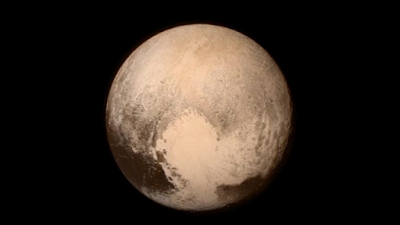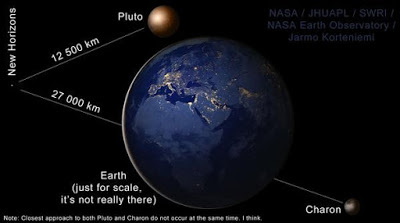New Horizons reached Pluto and all mankind should stand up and celebrate because this is an incredible achievement.
 Fran Bagenal demonstrates how we should all feel about New Horizons and
Fran Bagenal demonstrates how we should all feel about New Horizons andseeing Pluto up close and personal for the first time in history.A lot can happen in nine years. When the New Horizons spacecraft launched, Pluto was still a planet. However, it was relegated to dwarf planet status by the International Astronomical Union in October 2006. It went from being this thing we all learned as the ninth planet to "a celestial snowball with a surface of methane ice 3.6 billion miles from the sun." But like all good stories, the story of Pluto does not end there.
New Horizons didn't actually have to travel the whole 3.6 billion miles. It got to travel just over 3.26 billion miles because Pluto is one of those strange astronomical things that every once in a while, invades Neptune's orbit like the rogue it is. And when NASA switched New Horizons into data gathering mode for the encounter which took place yesterday, it started to receive images like the one below that you may have seen on NASA's instagram:
 Pluto has a heart shape on it almost as if it were welcoming New Horizons to its special corner of the universe. This also isn't a picture that was snapped at its closest approach. So more images are to come which will probably be mind-blowing-ly awesome.
Pluto has a heart shape on it almost as if it were welcoming New Horizons to its special corner of the universe. This also isn't a picture that was snapped at its closest approach. So more images are to come which will probably be mind-blowing-ly awesome.Pluto has several satellites. One is a moon called Charon (750 miles in diameter) which if you know anything about Greek mythology actually makes sense as Charon was the boatman to the River Styx while Pluto was the Lord of the Underworld. As you can see below, the distance between Pluto and its moon is so wide, you could fit one whole Earth between them. I like how there's a disclaimer of (Earth just for scale, it's not really there). I guess some people might have been confused because...science. It's other moons are Hydra, Kerberos, Nix, and Styx.
 Some of the tidbits that NASA has shared with us are:
Some of the tidbits that NASA has shared with us are:1) Pluto has a much younger surface than it's battered moon Charon. This makes scientists think that there could possibly be tectonic activity on this distant dwarf planet.
2) New Horizons has gathered so much data on Pluto that it will take 16 months to receive it all.
3) New Horizons is powered by plutonium, which is actually named after Pluto. The nuclear battery transforms heat into electricity, and will keep the probe in power until sometime in the 2030's. Until then, it will just keep sending back information.
4) It has a methane and nitrogen ice cap on its north pole (at -223 to -233 degrees Celsius). It's so cold that the ice wouldn't even be slippery.
5) NASA knows its awesome: yesterday was the 50th anniversary of the first image sent back from Mars.
6) It's surprisingly bright on Pluto which should give you new respect for the power of the Sun. You can actually go to this website for Pluto time so you can go outside at the time of day when it would be the equivalent of high noon on Pluto (Hint: It's not dark). My mind is blown thinking of how a ball of fire could light up something so completely from so incredibly far away. Then again, on one hundred degree days I've often thought of how immense and powerful the sun is to make it that unbearable from 93 million miles away--that's one hell of a heater. People, we are living in amazing times. Mankind is finally beginning to chip away at the vastness of space. We've discovered thousands of planets out there, billions of galaxies, and I just recently heard that NASA is going to Europa because they think there's a liquid ocean on Jupiter's famous moon, and they want to find out if that's true. I think we should all take a pause from our latest outrage (choose your flavor of the week: Confederate Flag, Iran Deal, Greece Bailout, Serena Williams has been body shamed, Atticus Finch is a racist, Donald Trump thinks all Mexicans are rapists) go out after dark, and just turn our eyes upward at the stars and think about how much we have to learn and how far we have come. Maybe if everyone did this, we could develop a sense of community as a species and manage to treat one another decently for a little while and stop ruining our planet.
Published on July 14, 2015 23:13
No comments have been added yet.



